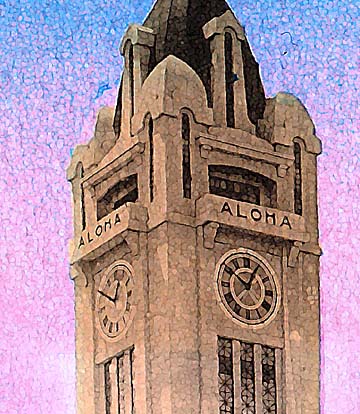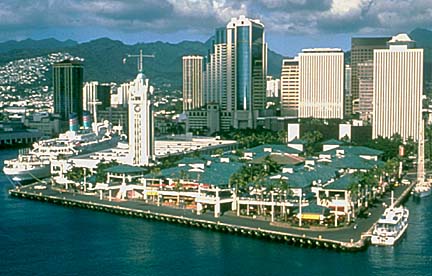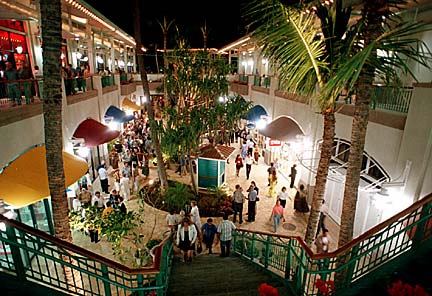


Aloha tower
A celebrity from the past
Still a monument to aloha By Scott Vogel
talks about the years he was
a star to be reckoned with
Star-Bulletin
He's been called a spectacular monolith, a sell-out, a kitschy throwback and a romantic reminder of Hawaii's golden past. In short, Aloha Tower is a celebrity, and like all celebrities, his life is grist for the public mill, his privacy nonexistent, his every move chronicled by an ever-prying media.Understandably, the tower is press-shy; he's no doubt been burned many times before. Still, on the occasion of his 75th birthday, Aloha Tower offered the Star-Bulletin a rare, exclusive glimpse at life on the waterfront, sitting for a short interview. We offered him this forum as an opportunity to set the record straight, and during a free-wheeling, hourlong conversation, the tower spoke lovingly, if cautiously, about his illustrious past, and candidly about his monumental present and future.
"On Boat Days, I was a star," the tower remarked casually, his demeanor stately and fortress-like. "Sure, they came for the streamers. They came for the leis, the Royal Hawaiian Band, Hilo Hattie, all that. But I was the main drawing card -- the headliner, if you will. The first thing you saw when you arrived, and the last thing you saw when you left were those letters A-L-O-H-A engraved in reinforced concrete."

A certain amount of ego is allowable here. After all, it can't be easy for the tower, once the city's tallest structure at 10 stories and 184 feet, to live with the fact that he's now dwarfed by every garden-variety condominium. (His height is even approached by a few of the cruise ships that glide past him in the harbor.) Given this reversal of fortune, it's not surprising that the tower gets nostalgic for his salad days, and especially a breathless Star-Bulletin advertisement from May 26, 1926."Have you ever thought of paint in acre quantities?" the ad demanded, before informing us that E. O. Hall and Son used 1400 gallons of "Eggshell Mill White" on Aloha Tower, which was further constructed of "6000 barrels of Portland Cement, several tons of Empire Plaster and a quantity of Waianae Hydrated Lime." The tower's 12-foot-diameter clock was also heralded.
"Though this ponderous timepiece, with dials and solid, cast-bronze frames, weighs seven tons, it is guaranteed to keep accurate time within a variation of thirty seconds a month," a feat which is still accomplished to this day, barring the clock's occasional defacement by vandals. In fact, the tower is in remarkably good condition for a 75-year-old, even if he is something of a relic.
"I haven't changed, but the world around me certainly has," the tower admitted while scanning the marketplace at his feet and the skyscrapers on the horizon. "Where once you got a lei greeting, now you're greeted by Aloha Tower Sundries -- and their bumper stickers saying things like, 'I killed a six-pack ... just to watch it die.' Once upon a time you arrived on the stately Lurline; now it's motor coaches and mini-buses, taxis and trolleys. Once you'd throw pennies to island boys who dove into harbor waters in hot pursuit. Now those kids would have to retrieve 50,000 pennies just to pay the $500 fine." The tower, it seems, has become a bit jaded.

"I don't mind telling you that it's all too much for a tower of my age. Think of it. Upon arrival, passengers were formerly whisked off to luaus. Now they're off to Hooters for hot wings. As you might imagine, I'm a bit worried about my legacy, especially with Aloha Tower Traders closing up shop and offering tower logo T-shirts and hats at half-price. What will become of me?"The edifice was gently reminded that he is now a national landmark, and as such is under greater protection than at any time in his history. (Far greater protection than, say, during World War II, when the tower was painted with green and brown camouflage, as if that would render the city's tallest structure inconspicuous.) At present, he cannot be altered in any way, a far cry from the 1920s, when tourists of every stripe offered suggestions on making this bell-tower-looking structure more, well, bell-like.
"The Aloha Tower is mute!," exclaimed Sir Alfred T. Davies in 1929, dilating on an idea he first put forward at a YMCA luncheon. "How delightful would it be if its silence were converted into eloquence ... A tower is usually the difficulty and main item of expense. But here, in Honolulu, you have a notable one ready to hand. It need only what I imagine would be a certain amount of adaptation of its topmost storeys and the addition of the requisite set of carillon bells, to make the present tower articulate in music and thereby more expressive of its true purpose."
History does not record the response of the YMCA to Sir Davies' suggestion. Nevertheless, it can be inferred that his request fell on deaf ears. Except for a few cosmetic improvements and the clearing away of surrounding structures in 1994, the tower -- from its stucco finish to its convexly-rounded pyramidal dome -- remains pristinely preserved. And there's still only one way to get to the top: via the "Automatic, Push-Button Type Otis Elevator," Oahu's first. ("It's about the size of the elevator in that French hotel we stayed in," said a well-heeled mainland tourist as we gently glided to the observation deck. "Man, that was a pit.")

Gazing from the lookout at the aqua harbor and the sea beyond, it was impossible to ignore either the world of Old Honolulu or O.A. Bushnell's book "A Walk Through Old Honolulu." Despite a laughable first line ("The city of Honolulu exists because of its harbor, and for Honolulu, history began in 1792 or 1793 ..."), the slim volume helpfully reminds us that Aloha Tower is built on sacred ground, on the site of a temple of healing erected by priests of the Heiau of Pakaka.Other 18th century Hawaiians may have considered this land "too hot and too dull for them to endure," but the priests, and later the cruise-line passengers, and later still the marketplace merchants, have spruced things up mightily, and the area remains a variegated, multipurpose attraction to this day, even if there is just one bona fide star on the premises.
"They call me the 'Statue of Liberty of Hawaii,' the tower mused, "even though I'm no lady and I'm dedicated to an entirely different idea. Still, I'm in good company, wouldn't you say?"
Kick-off festivities for the 75th anniversary of the Aloha Tower: Celebration of aloha
Events: May Day lei contest; sidewalk sale at the marketplace; traditional chant and blessing of Aloha Tower; performances by hula halau and guest speakers.
When: 4 to 5 p.m. tomorrow
Place: Aloha Tower Marketplace at the base of Aloha Tower
Admission: Free
Call: 566-2337
| | |
HAWAII was a different place when I first came to Honolulu as a fuzzy-faced teen-ager in 1956. Tourism was the fourth largest industry behind sugar, pineapple and the military. 10-story building
By Dave Donnelly
still a towering
monument to aloha
Star-BulletinThere were 218,000 visitors to Hawaii in '56, a figure attained in 2001 about every 11 days. A large percentage of those tourists came by cruise ship, and the tallest structure in the state was Aloha Tower, which, well, towered over downtown Honolulu 10 stories up. It also served as the first greeting for a great many tourists who sailed in and read at the top, "Aloha."
It was the tallest man-made building in the state from its construction in 1926 until 1970. The 184-foot high tower stood out not just because of its height, but because the clocks at the top were a handy way to tell time, and the message of "Aloha" on all four sides was a reminder you were in a happy place.
You could take the elevator to the top and see in all four directions without apartment buildings or office structures getting in the way. Not a bad investment, considering it cost $351,053 to build.
The powers that be dictated the tower be repainted and camouflaged during World War II. Some genius must have figured it would be a great target for Japanese aircraft.
Before the Aloha Tower Marketplace was built, and before City Councilwoman Rene Mansho was born, "Boat Day" was indeed a big deal. I remember strolling to the tower where the ocean liners of the day docked. They were met by tutu stringing and selling lei, island musicians playing and singing and young men who dived for coins tossed overboard by tourists.
Looking back, it wasn't unlike feeding pigeons at the zoo, but the boys who did the diving didn't mind, since a case of beer went for about $4 in 1956.
It was a colorful scene and the coin-diving youngsters knew it, and with their antics they were getting their feet wet, so to speak, in show business.
As towers go, ours is pretty meager. England has its Tower of London, built by William the Conqueror more than 1,000 years ago. Pisa has its famous tower, though a leaner. Paris and its Eiffel Tower made history when it turned 100 more than a decade ago.
The World Trade Center towers in Manhattan claimed to be the largest until the Sears Tower in Chicago somewhat over-shadowed them, except for their antennae. The Petronas Towers in Kuala Lumpur, of all places, shot up higher than the roof of the Sears Tower if you count the spires. And the CN Tower in Toronto is the tallest freestanding structure in the world, standing at just over 1,815 feet with the highest public observation deck at 1,465 feet.
Music has its Tower of Power. Movies have their "Towering Inferno." People would seem obsessed with towers. I'll leave any psychiatric interpretation to the Freudians.
So while Aloha Tower is far from the oldest or the highest, at least it doesn't lean. And to those who see it, the feeling of aloha comes across as real, and not just something concocted to sell a marketplace.
So, aloha, tower. And may you keep sending out your own island greeting as you've done for 75 years. We can all use it.
Click for online
calendars and events.